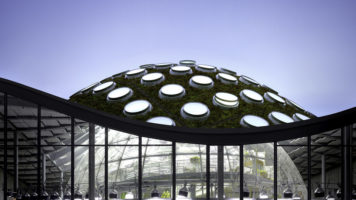By Chelsea Stuart
We all know that museums are dedicated to the preservation of history, art and culture, but what about the environment? While the answer is usually a resounding ‘no,’ the following institutions are hard at work valuing not only relics of the past, but the future state of earth’s delicate climate. Designed for maximum efficiency and putting to use solar power, wind power, and ‘trigeneration’ systems (in the name of carbon emission reduction)— these museums are truly works of art themselves.
Museum of Liverpool
Photo via the Museum of Liverpool
The Museum of Liverpool features exhibits on the history of the port town, its people and its international significance, but the real crowning jewel of the institution is hidden behind the scenes. The greatest component of their sustainability effort is their ‘trigeneration’ heating, cooling and electric system. The integrated process reduces carbon emissions by 884 tons a year—“equivalent to the environmental benefit of 88,400 trees”— allowing for extreme energy efficiency. Reducing their carbon footprint was especially necessary as their location in the old port was named a UNESCO World Heritage site in 2004.
Jeongok Prehistory Museum
Photo via Inhabitat
Right off the bat you’ve probably noticed that the aesthetic of the Jeongok Prehistory Museum is rather jarring given its natural surroundings. The building is a chrome tube which loops through the site where the first Acheulian hand axe was unearthed after all. But its design pays homage to the river which runs nearby as well as the evolution of Korea and the first men. Aside from looking sleek, the perforated chrome exterior actually serves to allow sunlight to enter while also preventing heat conduction. The system of double walls that encloses the building makes sure that the interior maintains a constant temperature in the most energy efficient way possible.
The Natural History Museum of Utah
Photo via Jeff Goldberg/Esto
The Natural History Museum of Utah has set a goal to achieve LEED Gold certification in the next two years. One thing currently in the works is the installation of 1,400 solar panels which will ultimately provide 25 percent of the museum’s total energy power. As for current operating practices, the building uses two 10,000-gallon cisterns on the roof to collect rain water which is used to irrigate the whole site. The exhibits also use motion censored lighting to ensure that no unnecessary energy is spent and the outdoor lighting has achieved LEED “dark sky” requirements meaning they won’t contribute to light pollution.
Boston Children’s Museum
Photo via Boston Children’s Museum
When the museum made a 23,000-foot addition to their space in 2007, its team worked to ensure that the renovation would maximize the building’s renewable and reusable energy. Part of the construction included a 6,400-foot green roof which is now occupied by an array of plants and organic materials which help to insulate the building, collect storm water, and reduce air pollution. Their ecologically friendly efforts paid off when they were the first Boston museum to be awarded a LEED Gold rating, but museum president Casagrande says that it doesn’t stop there. As he wisely noted, “It’s going to take a couple of generations to change the way we all live. Our job is to role-model that now, so kids internalize the message and see it as a positive, doable, necessary thing.”
The Grand Rapids Art Museum
Photo via Grand Rapids Art Museum
The GRAM, as it’s known, was the world’s very first LEED certified museum. But what set it apart? For starters the museum stores and recycles all rain water and snow for toilets, plant irrigation, pool and water wall; its energy efficient skylights are tailored to control light allowance based on the needs of the art in each exhibit, the building is insulated by recycled paper and fiber, and they encourage employees to bike to work and use provided staff showers. On a more basic level, the building materials were also sourced from local businesses and the White Oak flooring throughout was sustainably harvested from forests in the Northwest.
Musee Du Quai Branly
Photo via Robert Mehl/Detail
The Quai Branly Museum showed its commitment to environmental protection when they signed the Sustainable Development Charter for Public Establishments and Enterprises in 2011. Responsible acts include using energy efficient light bulbs, reducing paper consumption by encouraging the digitalization of certain materials like tickets, and selling sustainable products like local organic foods in their cafeteria. The museum, located in Paris, is also known for its sprawling public access garden which is made up of 150 different plant species as well as a number of birds and other small animals. Since the large garden requires regular watering, the museum has invested in a weather controlled automatic drip system which takes into account the temperature and position of the plant to guarantee precise watering.
California Academy of Sciences
Photo via California Academy of Sciences
Established in 1853, the California Academy of Sciences is one of the world’s largest natural history museums. It is arguably most well-known for its iconic Living Roof on which 6 inches of soil insulates the building, prevents storm water runoff, and provides a home for local birds, butterflies and native plants. The Living Roof is also surrounded by a solar canopy comprised of 60,000 photovoltaic cells which supply 213,000 kWh of energy annually, cutting greenhouse gas emissions by 405,000 pounds. As for the interior, the building was designed with energy efficient floor-to-ceiling glass panels which not only reduce heat absorption and minimize the amount of energy needed to cool the space, but also permit the entrance of natural sunlight. FYI, if you’re planning a visit, you can save money on your admission by biking, walking or taking public transportation.
About the Writer
Feature photo via California Academy of Sciences
